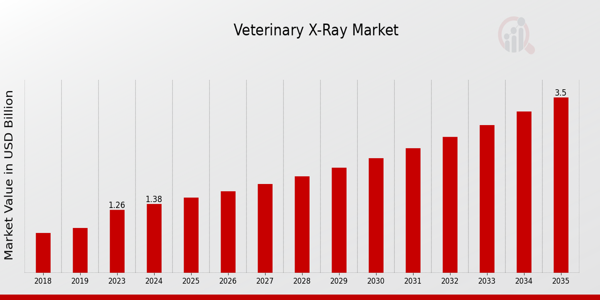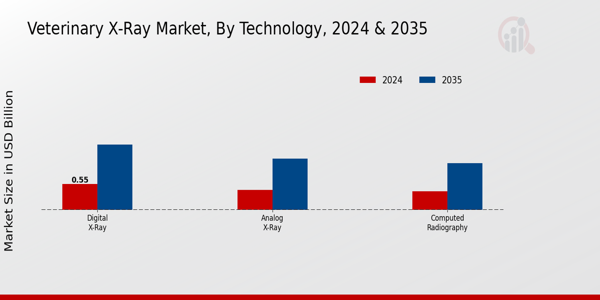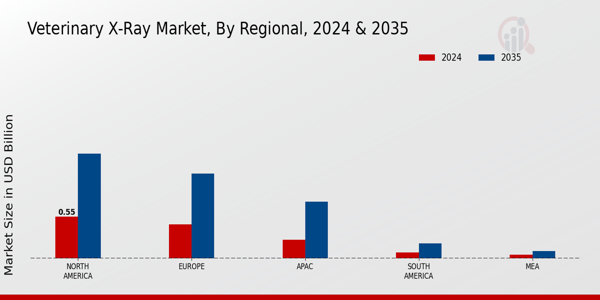Veterinary X-Ray Market Overview
As per MRFR analysis, the Veterinary X-Ray Market Size was estimated at 1.26 (USD Billion) in 2023. The Veterinary X-Ray Market is expected to grow from 1.38(USD Billion) in 2024 to 3.5 (USD Billion) by 2035. The Veterinary X-Ray Market CAGR (growth rate) is expected to be around 8.86% during the forecast period (2025 - 2035).
Key Veterinary X-Ray Market Trends Highlighted
The Veterinary X-Ray Market is experiencing significant growth driven by an increasing demand for advanced and accurate diagnostic tools in veterinary practices. The rise in pet ownership, particularly in urban areas, has led to a greater need for quality healthcare for animals. As pets are considered family members, owners are more willing to invest in their health, thereby boosting the demand for veterinary diagnostic equipment. Additionally, advancements in technology, such as digital X-Ray imaging and portable systems, are enhancing diagnostic capabilities and improving workflow in veterinary clinics. Opportunities in the market expand with the growing trend of telemedicine, which allows veterinarians to provide remote consultations and access diagnostic tools virtually.
The expanding adoption of animal imaging techniques in research and rehabilitation also presents significant avenues for growth. Moreover, emerging markets are seeing a rise in veterinary practices, creating a substantial demand for X-Ray equipment. There is potential for companies to explore collaborations and partnerships to enhance service offerings and cater to the unique needs of different regions. In recent times, there has been a noticeable shift toward the integration of artificial intelligence in veterinary imaging. This trend not only streamlines analysis but also increases diagnostic accuracy, which can lead to better treatment outcomes for animals.
Additionally, the focus on sustainability within the veterinary sector has prompted manufacturers to develop eco-friendly imaging solutions. As the market evolves, these trends indicate a promising future for veterinary X-Ray technology, with opportunities ripe for innovation and enhanced veterinary care.

Source: Primary Research, Secondary Research, MRFR Database and Analyst Review
Veterinary X-Ray Market Drivers
Increasing Pet Ownership and Spending on Animal Health
The growing trend of pet ownership globally has led to a significant increase in spending on animal health and well-being. As more households adopt pets, the demand for veterinary services, including diagnostics, has surged. The Veterinary X-Ray Market is on an upward trajectory as pet owners are increasingly willing to invest in advanced medical technologies for their animals. This trend is further supported by the rising awareness among pet owners about preventative healthcare, leading to more frequent veterinary visits.
As veterinarians adopt modern diagnostic modalities, the appetite for high-quality veterinary X-Ray equipment becomes more prominent, contributing to the market's expansion. Additionally, the increasing range of pet insurance policies has alleviated some financial burdens on pet owners, encouraging them to seek better healthcare options for their pets. The rise in disposable income across various demographics has also translated into higher spending power for veterinary services, fueling the need for advanced diagnostic tools.
Given increasing competition in the veterinary field, the need for modern diagnostic equipment, such as X-Ray machines in clinics and hospitals, is more prominent to guarantee precise and effective treatment. This shift in the market creates an opportunity for the Veterinary X-Ray Market to grow considerably in the next few years since more veterinarians will buy tools that help improve their ability to diagnose and treat different ailments in pets.
Technological Advancements in Imaging Techniques
Advancements in imaging technologies, particularly in digital X-ray systems, are a significant driver for the Veterinary X-Ray Market . Innovations such as digital radiography allow for quicker image capture and enhanced image quality, making it easier for veterinarians to diagnose conditions accurately. The development of mobile and portable X-Ray units further broadens accessibility, enabling veterinary professionals to provide care in diverse settings, including animal hospitals, clinics, and field operations.
These technological improvements are appealing not only for operational efficiency but also for enhancing the overall quality of care provided to animals, resulting in an increased demand for advanced veterinary X-ray solutions.
Growing Awareness of Animal Health and Welfare
There is a rising public awareness regarding animal health and welfare, which is contributing significantly to the growth of the Veterinary X-Ray Market . As society becomes more educated about the health needs of animals, pet owners are prioritizing regular check-ups and diagnostic screenings for their pets. This greater emphasis on animal welfare is fostering an environment where veterinarians can advocate the use of advanced diagnostic equipment, including X-Ray systems, to monitor and maintain animal health effectively.
The focus on preventative care promotes early detection of health issues, driving demand for reliable and advanced veterinary diagnostics solutions.
Veterinary X-Ray Market Segment Insights
Veterinary X-Ray Market Technology Insights
The Veterinary X-Ray Market has been making notable advancements, particularly within the Technology segment, which includes Digital X-ray, Analog X-ray and Computed Radiography. As of 2024, the overall market was valued at 1.38 USD Billion and is projected to extend this growth trajectory significantly. Among the different technologies employed, Digital X-Ray technology is gaining substantial traction, valued at 0.55 USD Billion in 2024 and expected to grow to 1.4 USD Billion by 2035, emphasizing its major role in the market. This increasing valuation for Digital X-Ray stems from enhanced diagnostic capabilities, faster imaging, and greater accuracy compared to traditional methods.
Analog X-Ray technology also maintains its relevance, with a valuation of 0.43 USD Billion in 2024 and anticipated to rise to 1.1 USD Billion by 2035, though it faces competition from more modern technologies. Despite being edged out by digital advancements, Analog X-Ray remains significant in specific applications where traditional imaging techniques are preferred. Computed Radiography, while poised at 0.4 USD Billion in 2024 and expected to reach 1.0 USD Billion in 2035, plays a critical role in bridging the gap between traditional and digital technologies, offering flexibility and retrofitting capabilities for existing analog systems.
The majority holding of Digital X-Ray highlights its appeal due to superior processing time and patient throughput, which are crucial for veterinary practitioners aiming to enhance patient care and operational efficiency. The growing acceptance of these technologies is bolstered by a rise in pet ownership and an increased focus on animal health, driving demand for more sophisticated imaging options. Challenges remain, including the need for high initial capital investment and ongoing maintenance costs. However, the opportunities present in expanding capabilities through AI integration and telemedicine applications could further amp up market growth, emphasizing the dynamic changes driven by Technology in the Veterinary X-Ray Market.
Each of these segments contributes to the broader Veterinary X-Ray Market revenue, showcasing the diverse technological landscape and the strategic shifts within the industry, pushing for continuous improvements and adaptations to meet the evolving needs in veterinary care. The market statistics underscore a promising trajectory, building a comprehensive picture of how technology is transforming veterinary diagnostics, creating potent avenues for growth, and establishing a clearer view of the industry's future developments.

Source: Primary Research, Secondary Research, MRFR Database and Analyst Review
Veterinary X-Ray Market Application Insights
This growth trajectory is largely driven by the increasing prevalence of veterinary diseases and advancements in medical imaging technologies. Within the Application segment, Orthopedics and Dentistry play a crucial role, as many veterinary practices rely on X-Ray imaging for diagnosing musculoskeletal issues and dental conditions, respectively. Cardiology is also a major contributor, providing essential diagnostic imaging to manage heart diseases in animals.
Oncology remains significant as well, given the rising incidence of cancer in pets, which necessitates accurate and timely diagnostic methods. The Veterinary X-Ray Market segmentation reflects a diverse range of applications, with each area contributing to improved animal healthcare outcomes. Increasing awareness about animal health and the importance of timely diagnostics underline the opportunities within this market, although challenges such as high operational costs and the need for skilled professionals persist. Overall, the Veterinary X-Ray Market data shows robust potential across multiple applications, indicating a dynamic and evolving industry landscape.
Veterinary X-Ray Market End Use Insights
The Veterinary X-Ray Market is witnessing significant growth, particularly in its End Use segment. Veterinary clinics represent a crucial component, handling a substantial portion of the imaging needs due to the high volume of routine examinations. Animal hospitals also play a vital role, as they often have more advanced imaging technologies, thereby dominating complex diagnostics and surgeries. Research institutes contribute uniquely with specialized imaging required for veterinary research and studies, addressing specific animal health issues.
The importance of these facilities highlights the diverse applications of veterinary X-ray technology, driven by factors such as rising pet ownership and the need for advanced diagnostic capabilities. Continuous evolution in imaging technologies and growing awareness about animal health present further opportunities within this sector. The Veterinary X-Ray Market statistics emphasize the critical role that these end-use categories play in enhancing animal care and the overall industry growth.
Veterinary X-Ray Market Animal Type Insights
The Animal Type segment of the Veterinary X-Ray Market plays a crucial role in the overall evaluation and growth of the industry. This segment encompasses various animal types, including Canines, Felines, Equines, and Exotics, each contributing to a diverse market landscape. Canines and Felines are particularly significant due to their prominence in companion animal care, leading to a majority holding in the market.
Equines also represent a substantial part of the market, driven by the competitive nature of horse racing and the need for high-quality veterinary care. Moreover, the inclusion of Exotic animals highlights the expanding scope of veterinary services, catering to a niche audience. The growth of this segment is supported by various trends, including technological advancements in imaging technology, increasing pet ownership, and a growing awareness regarding animal health. Challenges may arise from regulatory issues and the high costs associated with advanced imaging systems, yet opportunities exist in enhancing diagnostic capabilities for diverse animal populations.
The Veterinary X-Ray Market data reflects a dynamic and crucial component of veterinary services as it continues to evolve.
Veterinary X-Ray Market Regional Insights
The Regional analysis of the Veterinary X-Ray Market reveals a robust landscape characterized by significant market revenue contributions across various areas. In 2024, North America leads the market with a valuation of 0.55 USD Billion, reflecting its majority holding in the Veterinary X-Ray Market. This dominance is likely attributed to advanced veterinary practices and high adoption rates of diagnostic imaging. Europe follows closely, valued at 0.45 USD Billion, showcasing its noteworthy presence due to strong regulatory frameworks and significant investment in animal healthcare.
Meanwhile, the APAC region, valued at 0.25 USD Billion, presents notable growth potential as awareness and accessibility to veterinary services increase, positioning it as a significant player in future market developments. South America, with a valuation of 0.08 USD Billion, and the MEA, with 0.05 USD Billion, are comparatively smaller yet crucial segments, reflecting growing investment in veterinary infrastructure amidst increasing pet ownership and healthcare demands. Overall, the Veterinary X-Ray Market segmentation underlines the crucial roles these regions play in shaping the industry's overall growth trajectory, with opportunities emerging from various trends and advancements in veterinary imaging technologies.

Source: Primary Research, Secondary Research, MRFR Database and Analyst Review
Veterinary X-Ray Market Key Players and Competitive Insights
The Veterinary X-Ray Market is witnessing significant growth, driven by increasing awareness regarding pet health and advancements in veterinary imaging technologies. The market is characterized by a diverse range of players focusing on innovative and efficient solutions that cater to the growing needs of veterinarians. Competitive dynamics within the market include a mix of established companies, emerging startups, and specialized firms that emphasize technological development to enhance diagnostic accuracy and patient care. This competitive landscape is further strengthened by collaborations, mergers, and acquisitions aimed at boosting product portfolios and expanding market reach to meet the evolving demands of animal healthcare.
DRE Veterinary has carved a strong niche within the Veterinary X-Ray Market, focusing on providing high-quality imaging solutions tailored for veterinary practices. The company is recognized for its robust product offerings, which include portable and fixed X-Ray systems that are user-friendly and reliable. DRE Veterinary's commitment to customer service has bolstered its market presence, allowing it to maintain strong relationships with veterinary professionals who seek dependable imaging technologies for accurate diagnostics. The company’s strengths lie in its ability to adapt to changing market trends and regulatory requirements, thereby ensuring that its product line remains competitive. Furthermore, DRE Veterinary's continuous investment in research and development enhances its capability to introduce innovative solutions that improve both efficiency and safety in veterinary practices, allowing it to stand out among competitors in the field.
Varex Imaging Corporation is another prominent player in the Veterinary X-Ray Market, known for its comprehensive range of X-Ray imaging components and solutions. Varex’s expertise lies in the design and manufacturing of advanced X-Ray tubes and digital detectors that cater specifically to veterinary applications. The company's strong focus on innovation and technology development positions it favorably within the competitive landscape. Varex Imaging Corporation further enhances its market presence by collaborating with veterinary equipment manufacturers to integrate its imaging technologies into their systems, thereby expanding its reach within the industry. The company demonstrates significant strength through its commitment to delivering high-performance imaging solutions that ensure both high-resolution images and efficient workflows, facilitating better diagnostic capabilities for veterinarians. This dedication to quality and innovation underscores Varex Imaging Corporation's role as a leader within the veterinary X-Ray market.
Key Companies in the Veterinary X-Ray Market Include:
- DRE Veterinary
- Varex Imaging Corporation
- Fujifilm Medical Systems
- Agfa HealthCare
- Idexx Laboratories
- Veterinary Radiology Associates
- Digital Imaging Systems
- MediCapture
- Siemens Healthineers
- Heska Corporation
- Carestream Health
- VetRay
- GE Healthcare
- Canon Medical Systems
Veterinary X-Ray Market Developments
Recent developments in the Veterinary X-Ray Market indicate a growing emphasis on technological advancements and enhanced imaging solutions. Companies such as DRE Veterinary and Varex Imaging Corporation are focusing on improving the precision and efficiency of veterinary imaging equipment. Meanwhile, Fujifilm Medical Systems and Agfa HealthCare are introducing innovative digital X-ray devices aimed at making diagnostics quicker and more accurate for veterinary practices. Current affairs highlight a trend towards mergers and acquisitions as organizations seek to expand their market presence and strengthen their product portfolios; notable players like Idexx Laboratories and GE Healthcare are exploring strategic partnerships. The acquisition activity is reflected in the movement of entities looking to bolster their technological capabilities and gain competitive advantages.
Additionally, the valuation of companies like Siemens Healthineers and Canon Medical Systems has seen significant growth, driven by increased demand for diagnostic imaging solutions in veterinary medicine, further emphasizing the market's expansion. This growth is also positively impacting the overall veterinary healthcare sector, with enhanced imaging supporting improved animal care outcomes across the industry.
Veterinary X-Ray Market Segmentation Insights
Veterinary X-Ray Market Technology Outlook
- Digital X-Ray
- Analog X-Ray
- Computed Radiography
Veterinary X-Ray Market Application Outlook
- Orthopedics
- Dentistry
- Cardiology
- Oncology
Veterinary X-Ray Market End Use Outlook
- Veterinary Clinics
- Animal Hospitals
- Research Institutes
Veterinary X-Ray Market Animal Type Outlook
- Canines
- Felines
- Equines
- Exotics
Veterinary X-Ray Market Regional Outlook
- Middle East and Africa
North America
- Europe
- South America
- Asia Pacific
| Attribute/Metric Source: |
Details |
| MARKET SIZE 2023 |
1.26 (USD Billion) |
| MARKET SIZE 2024 |
1.38 (USD Billion) |
| MARKET SIZE 2035 |
3.5 (USD Billion) |
| COMPOUND ANNUAL GROWTH RATE (CAGR) |
8.86% (2025 - 2035) |
| REPORT COVERAGE |
Revenue Forecast, Competitive Landscape, Growth Factors, and Trends |
| BASE YEAR |
2024 |
| MARKET FORECAST PERIOD |
2025 - 2035 |
| HISTORICAL DATA |
2019 - 2024 |
| MARKET FORECAST UNITS |
USD Billion |
| KEY COMPANIES PROFILED |
DRE Veterinary, Varex Imaging Corporation, Fujifilm Medical Systems, Agfa HealthCare, Idexx Laboratories, Veterinary Radiology Associates, Digital Imaging Systems, MediCapture, Siemens Healthineers, Heska Corporation, Carestream Health, VetRay, GE Healthcare, Canon Medical Systems |
| SEGMENTS COVERED |
Technology, Application, End Use, Animal Type, Regional |
| KEY MARKET OPPORTUNITIES |
Rising pet ownership trends, Advancements in imaging technology, Increasing animal healthcare spending, Expansion of veterinary practices, Growing demand for portable X-ray systems |
| KEY MARKET DYNAMICS |
Growing pet ownership trends, Advancements in imaging technology, Increasing veterinary diagnostic needs, Rising awareness of animal health |
| COUNTRIES COVERED |
North America, Europe, APAC, South America, MEA |
Frequently Asked Questions (FAQ) :
The Global Veterinary X-Ray Market is expected to be valued at 1.38 USD Billion in 2024.
By 2035, the Global Veterinary X-Ray Market is projected to reach a value of 3.5 USD Billion.
The expected CAGR for the Global Veterinary X-Ray Market from 2025 to 2035 is 8.86%.
North America is expected to hold the largest market share, valued at 1.38 USD Billion by 2035.
Digital X-Ray technology is valued at 0.55 USD Billion in the Global Veterinary X-Ray Market for 2024.
Key players in the Global Veterinary X-Ray Market include companies like DRE Veterinary, Varex Imaging Corporation, and GE Healthcare.
The market value of Analog X-Ray technology in the Global Veterinary X-Ray Market is expected to reach 1.1 USD Billion in 2035.
The APAC region is expected to have a market value of 0.75 USD Billion in the Global Veterinary X-Ray Market by 2035.
The Computed Radiography segment in the Global Veterinary X-Ray Market is valued at 0.4 USD Billion in 2024.
The Global Veterinary X-Ray Market faces challenges such as regulatory compliance, while opportunities include technological advancements and increasing pet ownership.

















